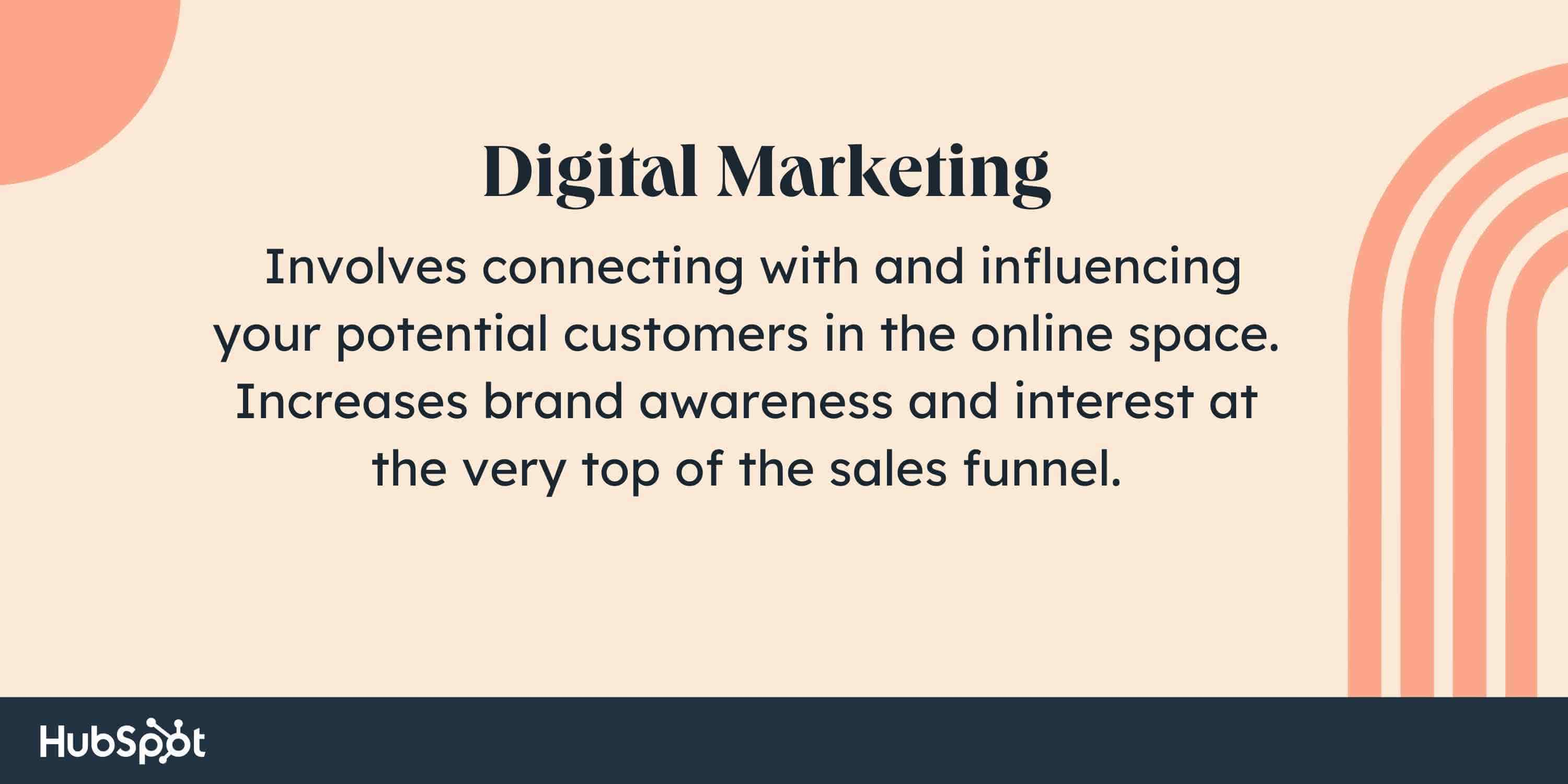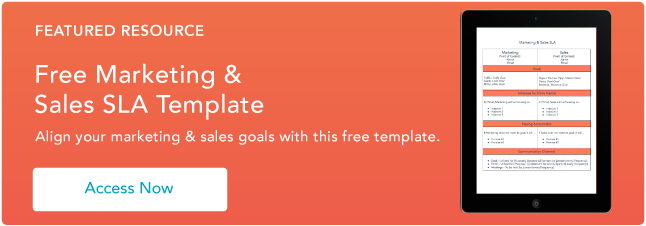Digital Marketing
Let's start with digital marketing. Simply put, digital marketing involves connecting with and influencing your potential customers in the online space. It’s meant to increase brand awareness and interest at the very top of the sales funnel by building a positive reputation online.
Digital marketing is an online engagement effort that uses a variety of assets, including websites, videos, images, written content (blogs or ebooks), and social media pages to connect with customers. It also includes specific strategies to drive engagement, such as pay-per-click advertising, paid search, search engine optimization, and paid social.

Digital marketing is a powerful practice that enables businesses to get in front of the right people at the right time and improve the possibility that those people will choose their organization.
If you’re in a purely online world, your digital marketing efforts can be fantastic for converting sales. But for many businesses, online interaction isn't enough. This is where digital selling comes into play.
Digital Selling
In contrast to digital marketing, digital selling is working to turn your audience into buyers. It’s responsible for driving revenue. A well-designed digital selling effort leverages digital tools (CRM systems, content management platforms, lead-generation resources), social platforms, and various communication methods for winning business.
Don't get me wrong, digital marketing efforts can, and often do, impact revenue, but digital selling is focused solely on driving sales.
-jpg.jpeg)
Digital selling efforts are divided into two prospect engagement functions.
Inbound Sales Activities
The first segment supports inbound activity from potential buyers. These are prospects that visit your website, respond to offers, and reach out with interest in your organization — most likely coming from digital marketing efforts that aimed to connect with your target audience.
For this reason, sales and marketing need to work together to develop messaging and selling strategies that ensure the collaborative effort creates a seamless experience for the prospect.
Outbound Sales Activities
The second function of digital selling revolves around the team’s outbound effort. This is what truly differentiates a robust digital selling effort from an average one.
In an outbound selling approach, the team uses a variety of resources to research potential prospects, connect with potential leads, and schedule interactions — the activities that turn prospects into customers.
These resources include search engines, social platforms, and lead generators that help digital sellers actively find leads.
It’s important to note that these digital sellers aren’t sitting by their computer waiting for leads to be handed to them — they’re proactive in their search. They’re also skilled at email communication and know how to speak to their value proposition concisely.
Unlike traditional salespeople, a digital seller has less time to build a relationship and capture a prospect’s attention. However, when digital sellers use their tools correctly, they’re more likely to win sales.
How to Implement a Digital Selling Strategy
These days, 56% of salespeople use social media to find new leads. Buyers are doing their research online in social spaces and various networking platforms, which makes it critical for salespeople to migrate to these same places.
With this in mind, let's discuss how to put a digital selling strategy into action.
-jpg.jpeg)
1. Ready your research.
Digital sellers understand the importance of research. Thorough research can include looking at a business market or an industry, specific companies, or critical individuals inside an organization.
As you dive into your research, consider leveraging industry groups, publications, and event organizers who can provide valuable insight into the current state of a business.
For example, I spent years in the home furnishings industry. During that time, I followed Furniture Today, the Mattress Industry Executives group on LinkedIn (yes, it exists), and the World Market Center out of Las Vegas.
These entities circulated tremendous amounts of material on the industry, the relevant organizations, and people. A research effort that leverages technology and multiple sources of information will provide a distinct advantage to a modern-day salesperson.
Pro-tip: Study the competition and analyze the online profiles of comparable businesses. SpyFu and other competitive research tools can provide a free analysis of your competitors' tactics.
2. Maintain a social media presence.
Sellers today must have a presence on social media. Which social platforms are relevant depends on your industry, however, LinkedIn provides access to a large pool of potential prospects.
Twitter and Instagram are also great platforms to be a part of, depending on your business model and ideal opportunity.
Start by selecting your platforms and establishing a personal brand. The key difference between social platforms for selling and social platforms is the intention of your presence. Social sellers realize that their profiles, activity, and connections are specifically for professional purposes.
There’s never been a better time to establish yourself as an authority or an expert in a specialty area thanks to social media. Check out tech reporter, Taylor Lorenz’s, TikTok — one of my favorite B2C examples of how to position yourself as the "go-to" person using social media.
Modern sellers can find the right people at the right companies through social media, and more importantly, your buyers can find you.
Pro tip: After you have a sense of the type of information that will interest your target audience the most, you can select the distribution methods most likely to provide positive outcomes.
Think about the many social media platforms at your disposal, and consider the role that each plays in helping you achieve your end goal.
3. Select the right tools and platforms.
Choosing the right technology tools to support your digital selling effort is essential. In searching for digital tools, it's easy to get overwhelmed by the amount of information available and the crazy number of options.
To keep things simple, start with a lead-generator resource. I’m a fan of LinkedIn Sales Navigator for its simplicity and cost. This tool helps to build and nurture customer relationships in a network.
Once you have a lead-generation platform started, select and prioritize the social platforms you will use. If you’re a B2B salesperson, then LinkedIn is a must. However, Facebook, Twitter, and Instagram could also provide value. Ask, "Where are my prospects spending their time?"
Recently, while on a call with a major provider of dental products, their head of sales mentioned that their sales team initially used LinkedIn as a prospecting resource with limited success.
Over time, they discovered many dentists (their primary customers) were spending their time on Facebook building their businesses and interacting with patients. Once this manufacturer's team shifted to Facebook, their conversion rate increased significantly.
Know your customer, and find the platform.
4. Leverage a CRM.
Lastly, it helps to have a customer relationship management (CRM) tool. Many companies have existing systems customized to their company and their buyers. Digital selling requires a more sophisticated way of managing relationships, and technology can help make it more efficient.
Creating a personalized experience for clients is key to establishing trust and a long-lasting relationship with them. The CRM gathers a huge quantity of data, which may then be divided into manageable chunks based on user-specified parameters.
For instance, customers of a similar age and with similar interests may be compiled into one database, making it easier for sales teams to target them.
Pro tip: If you don't have any coding experience, you can use HubSpot's form builder to create your own custom forms for your website to turn strangers into potential leads. If you have a form on your site, every visitor who submits it will be placed in a database where they may be nurtured with targeted emails.
Getting Started
Digital marketing and digital selling are both essential functions in any company that wants to compete in the world today. It's critical to understand the difference between the two to develop a holistic approach to driving revenue.
The digital transformation has created more opportunities for sales and marketing to work together to create a seamless customer experience. When the two functions collaborate on messaging, content development, and customer engagement, great things can happen.
Designing and activating a digital selling strategy will keep your pipeline filled with prospective customers and drive new revenue.
Sales and Marketing Alignment
.png?width=112&height=112&name=Image%20Hackathon%20%E2%80%93%20Vertical%20(46).png)
-2.jpg)
